I originally got a paella pan as a gift from my mom in the lead up to a trip to Spain that never happened. She said it was so I could ‘start practicing’ ahead of our visit.
‘Start practicing’??? But why would we be cooking paella in Spain???
The logical incongruity at the time of receiving it aside, the pan was something that I actually came to use. Frequently.
In full disclosure, my paella pan is not a traditional burnished metal or copper one. Instead, the one I have is kind of a weird alloy thing that is blue and feels halfway to a cast iron pan. It is a heavy duty bastard that is super solid and really best for large dishes.
Contrary to conventional logic, paella pans are actually fairly versatile. I use it for cooking segments of chopped tomato and peppers ahead blending them into salsa.
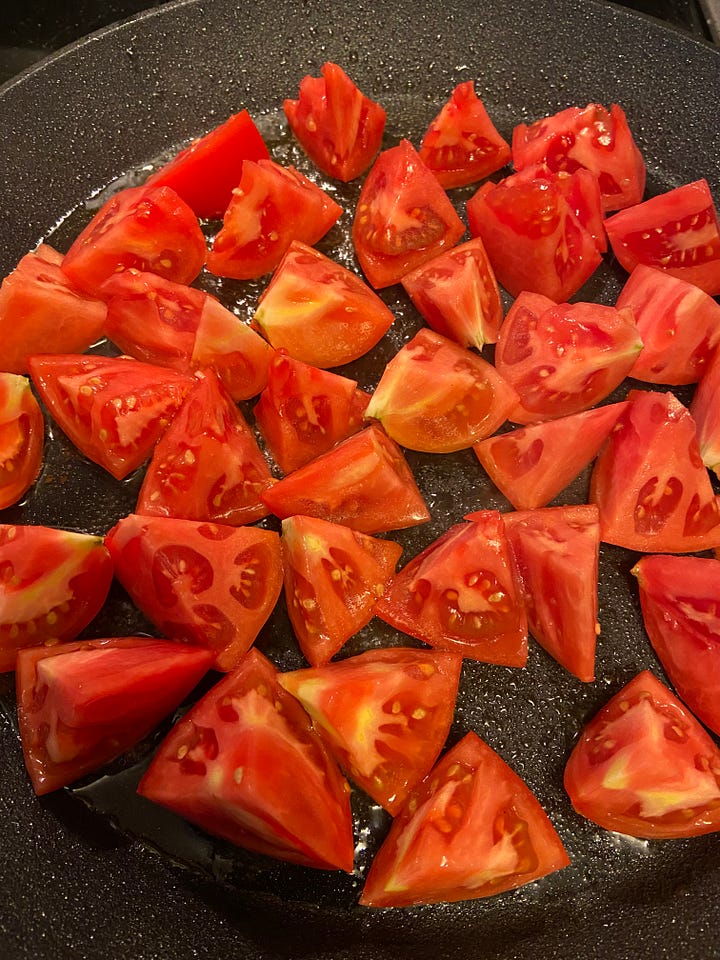
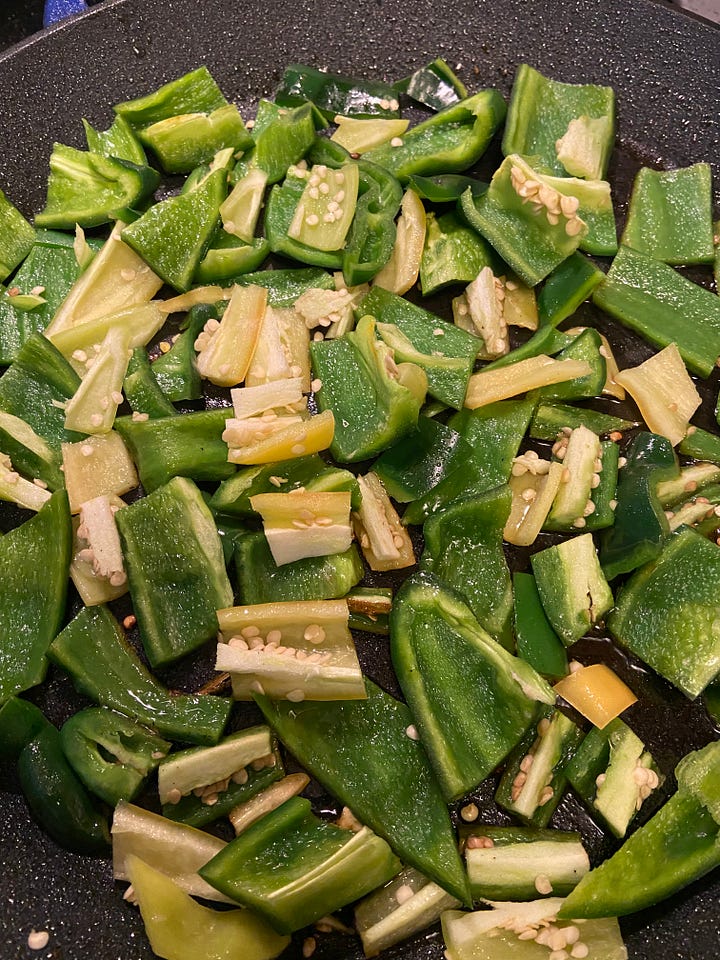
I also use it to fry chicken in a light amount of oil. This is one of my favorite uses for it, as the large surface conducts heat well and also allows me to position thighs in strategic architecture that lets the skin brown consistently and fat to render well so they don’t get slimy, but instead maintain a satisfying resistance to the tooth.
As fate would have it, the confusing messaging my mom shared when she gave me the pan came true. The trip to Spain was cancelled due to the Covid shutdown, and our family of three would instead spend the bulk of the next year-and-a-half together in the house eating what I cooked.
By the time we would eventually get to Spain, our family would be reduced to two of us. At that point, my understanding of paella would be very different from what initially seemed correct to me.
In 2000, I visited Spain for the first time, and the paellas I remember having were from lunch course menus offered in countless local restaurants all over the country. Usually there is a bar, some tapas in a case, and maybe a video gambling machine or two.
Paella would frequently be an option as the accompaniment to a modest protein of some unfussy stripe. Maybe liver or lomo. Maybe a simple fish. Served as a prelude, the paellas were usually more or less a side dish. The rice was thin and covered the bottom of the individual pan that was brought out. It was actually approaching a pegao—the crispy rice on the bottom of the pan they go nuts for in Puerto Rico.
In Latin America the paella tends to be the star of the show. It is significantly more loaded than the burnished and relatively light rice dish of Spain. I know there are some strict dogmas in Valencia about what is authentic, and most variants are dismissed as arroz con mariscos or arroz con ____, but in the Western Hemisphere the majority of paella is more closely resembling jambalaya than what they do in Spain.
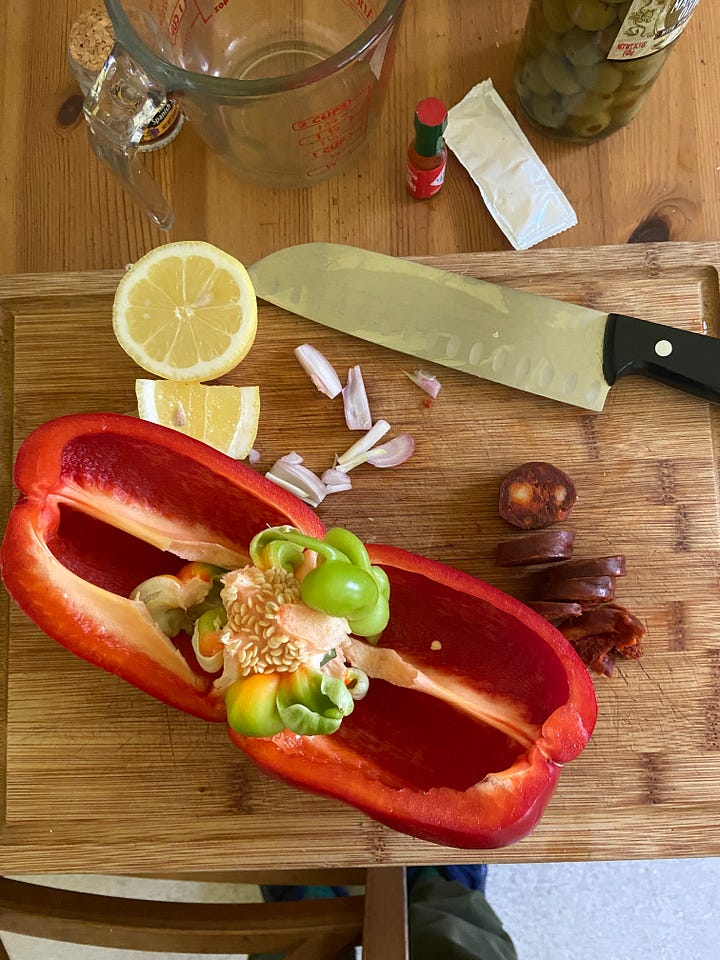



Very little is traditional in my style of cooking this dish, so I insist on adhering to a few principals. Start with olive oil in the paella pan. I use Bomba rice. I use saffron. Those are non-negotiable though the other ingredients vary.
If I am making it with chicken, then I would fry the thighs first since it takes the longest. I chop some of that vibrantly red Spanish chorizo and put it in the pan to impart some flavor and color to the chicken, then spend 15 minutes maneuvering it around so it evenly gives that fatty candy flavor that I like. When the chicken is done I put it aside for reincorporation later.
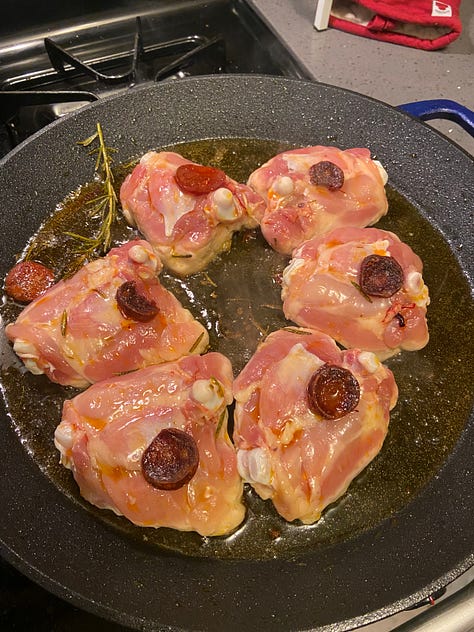

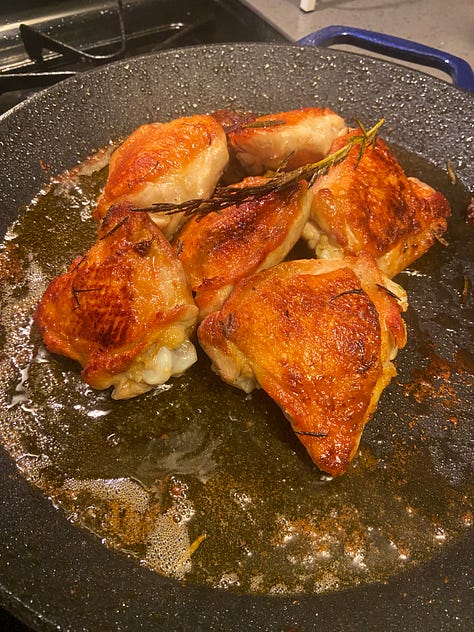
I would start to cook a sofrito of saffron, bell pepper, onion, tomato and olive in the pan. No garlic; it’s not necessary. All of that should be chopped small enough that it will break down to almost nothing and disappear into the rice. I cook that for a while so the sugars start to caramelize and the skin of the peppers stops resisting.
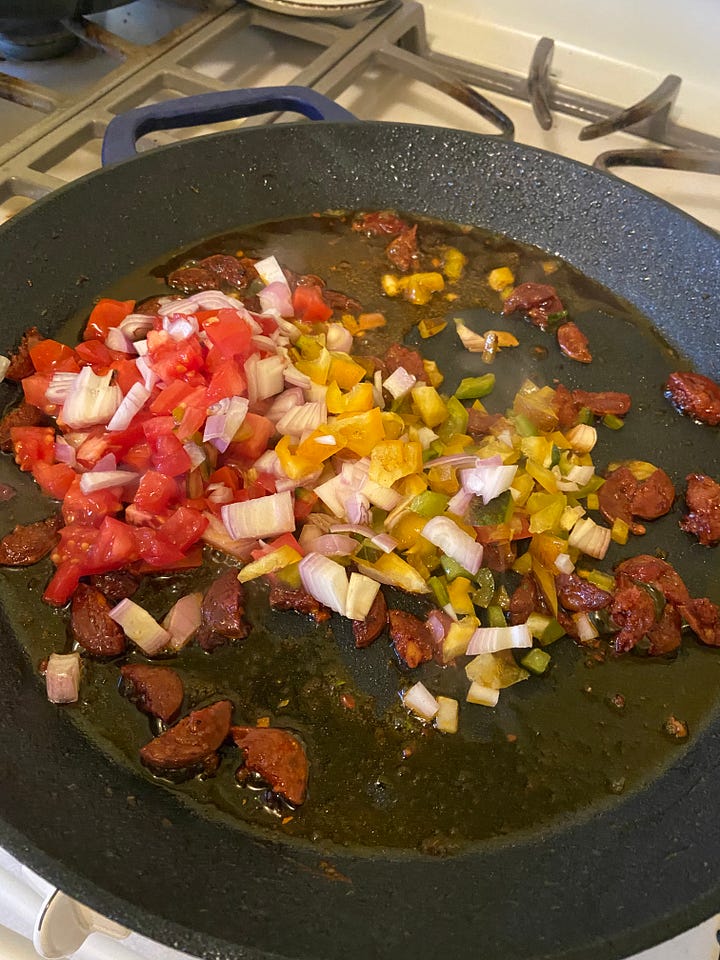
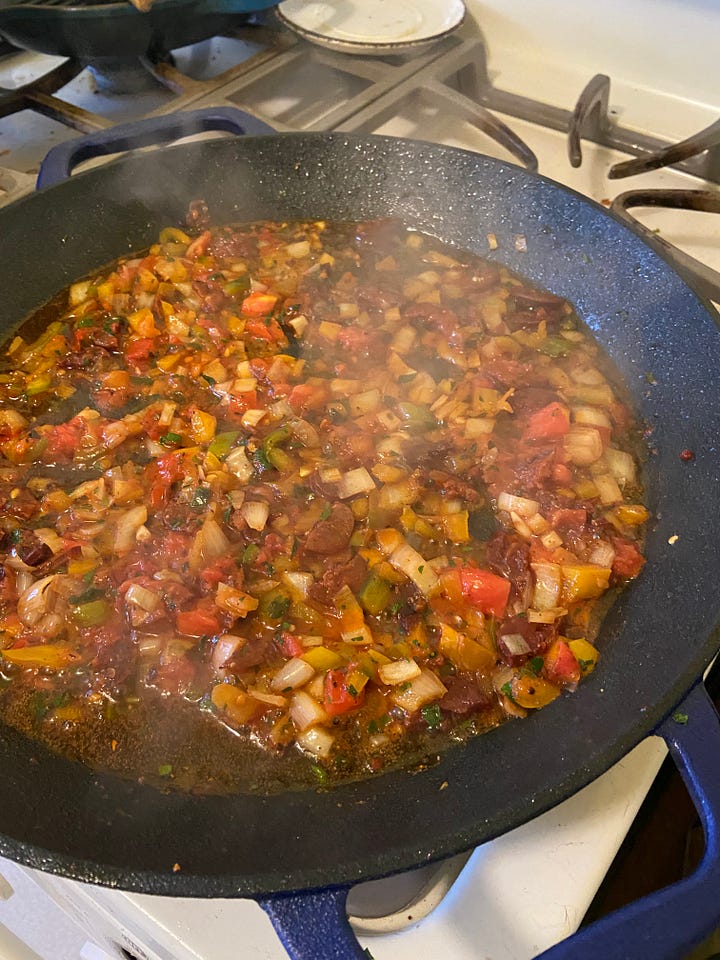
The most decisive element of the whole production probably comes down to how much rice to add. I used to add like 2 cups, but honestly that is a lot. The Spanish just use enough to cover the bottom of the pan, but that feels almost miserly—though definitely more concentrated than the stacked pan that I will eventually get days worth of leftovers from.
Lately, I would generally go closer to 1 & 1/4 cups of rice. It depends on how much stuff I am trying to add…will there be mussels? Chicken? Fish? Rabbit? The more stuff I try to ram in there, the more elements there are that need to be cooked right or run the risk of standing out as a miss.
I don’t tend to add water. The bomba rice is resilient and durable enough to absorb a true depth of flavor that feels wasteful to water down, so instead I use white wine and stock to cook in. Generally a whole bottle of wine and/or stock of shrimp peel and tails or chicken or whatever else is going in the pan later.
Rosemary is an herb that can be very off-putting for me so I don’t frequently use it, but it is still best to have around and its flavor makes this unique. Ideally it could be charred and used to briefly smoke the covered pan to add an even earthier, primordial nose. Good saffron should be present on the palate. Paprika will give smokiness to the back of the mouth that once in a while is reinforced by a piece of chorizo with its round, red oil.


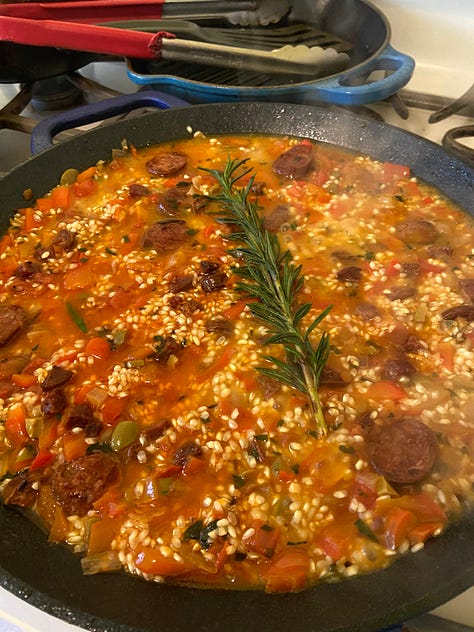
I know the dish should be cooked over wood—that is how it has been created and intended—so even though I have never cooked it over a wood fire I try to at least carry that idea to my range top and oven. The rice crawling up the slanted edges of the pan to get licked by the fire lashing from beneath.
Those rustic origins notwithstanding, I part-cook featured ingredients and remove them to reintegrate them throughout the whole process. If I just treated it as a jambalaya that I was adding to and not removing from then it would turn into a one note show where elements lost some meaning and juiciness. Making paella is actually revealing of a bunch of different techniques that need to be executed capably on a mutual timeline as cooking durable rice over fire.
Have the mussels withered into sad pencil erasers? Is the chicken still raw while the bottom has burned? Has the rice finished but the shrimp have turned to rubber? Did we achieve the fabled socarrat, where the grains’ edges crisp and are al dente and brassy? The traditional Spanish styles may be more workmanly and focus intently on a few details—chiefly the cook on the rice. But a paella that is more ambitiously stacked maybe unevenly executed. All of the finer little points of technique take an endless investment of practice to refine once the larger pitfalls have been clearly marked. How many ways will I cut the chorizo so some of it melts into the sofrito while some remains durable? Will I need to handle razor clams any particular way? What is the better technique for cutting olives that have pimento in them so they will be discernible for my girl to hunt for on her plate?
If there is fish in it, I want it to be moist and succulent. I would feel like a failure if the mussels were overcooked or if the shrimp got tough. I will replace chicken to the pan earlier since a thigh is pretty tough to overcook, but seafood is where a dish can be fumbled in a few unfocused minutes.

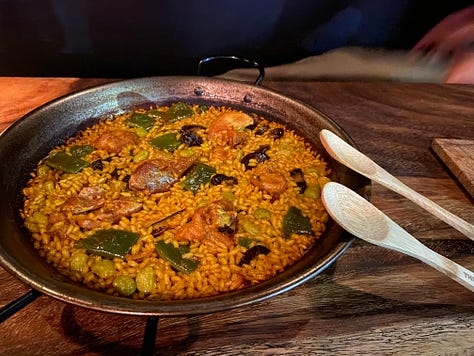
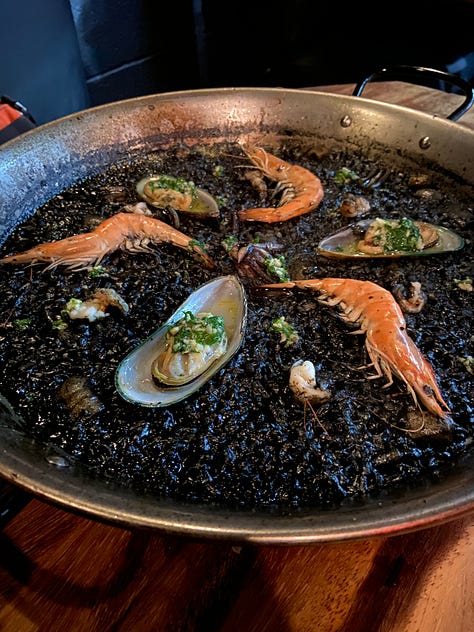
In traditional Spanish paellas and you can clearly see the rice gripping the pan all the way throughout. Mine are dense forests of seafood, chicken, rabbit…so the rice is rendered a supporting rather than lead player. My style has shifted progressively to decongest them, but rich habits die hard.
Still, I don’t feel too pressed to authenticate my version. It is, in its way, like Chicago style pizza. This is an innovation on a European traditional dish that also takes into consideration the markets and temperament of the people who are recreating them half a world away.
Ideas of authenticity are blurred when you consider that most of what is referred to as paella in Spain probably wouldn’t even be accepted as authentic in Valencia. So I don’t chase authenticity because that is a movable idea that would inhibit me from using the best things that are available.
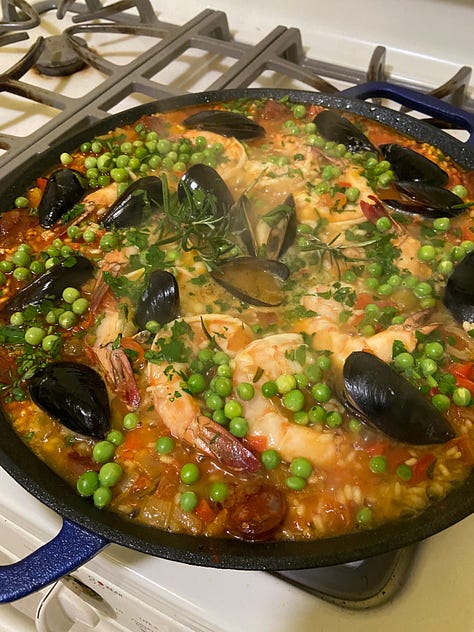
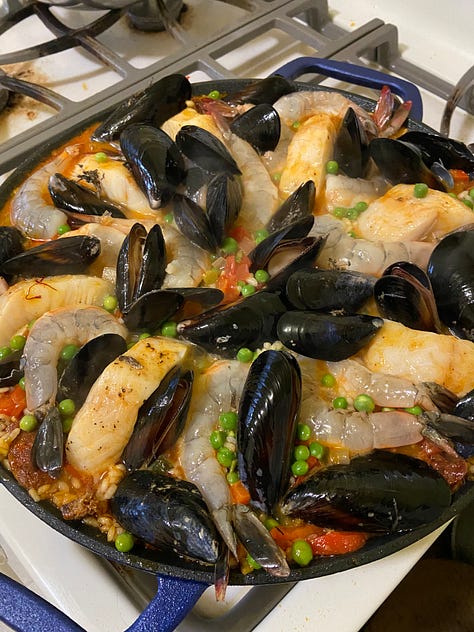

Conceptually, food should be about ingredients and their quality more than recipes. To go to a market and shop your recipe with an agenda is to not listen to the band before you start playing along. I go to the markets to see what looks freshest and can be sourced locally and then plan out. The only exception is the Bomba rice which is easiest sourced through Amazon of all the terrible places.
It may be conspicuously full and overly ambitious, but having the variety of textures and flavors from land, sea and air—served with this substantial and tangy rice, vibrates with a sentiment of occasion. It is intended to be lavish, an expression of extravagance. Abundant love in the face of heart-breaking losses and set-backs.

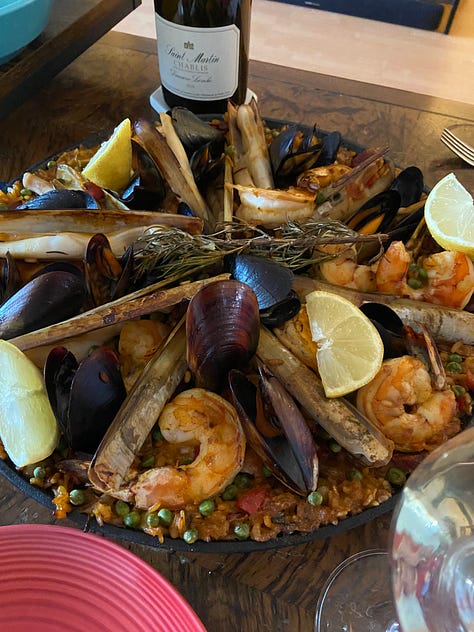

The first time I attempted a version with rabbit, it was sourced in Hollywood through a butcher who had taken over one of the storefronts owned by his family following the passing of his father. Now that he was in control of the small shop on a slightly grimy stretch of Santa Monica, he made it his model to stock great meat at a much more reasonable price than any competitor I’d found in LA. Though he operated the shop for a few years—offering wagyu beef, jidori chicken, and special ingredients like my rabbit—eventually he returned control to his family and that ambitious meat program was discontinued in favor of more predictable, practical fare.
He sold me a whole, skinned rabbit. Butchering it was similar to chicken but the smell of the meat was occasionally off-putting. It has a funkiness to it that is especially pungent when it is raw. The bones also handle differently, with a feel that can resemble quills. Those qualities reinforced how distinct it was from more accessible meats, and reminded me of the furry animal with its cuteness apart from its value as food. I resolved to get as much meat off the back, hinds, and anywhere else I could to value the unique sacrifice in our home. I sought out the kidneys and prepared them with care, as we had learned they could be exquisite at a dinner we ate a few nights earlier. I got as many small morsels as I could find and combined it with shrimp and Jimmy Nardello’s peppers. We invited friends to share it with that Friday night, at the end of the week my wife and I returned home from our long-delayed trip to Spain.
Maybe it was the extra awareness of sacrifice in the pan that made that paella something I still regard as special. Later on, I remembered that the very first meal my mother cooked for my father when they married was a rabbit fricassee.
Spain, 2023


